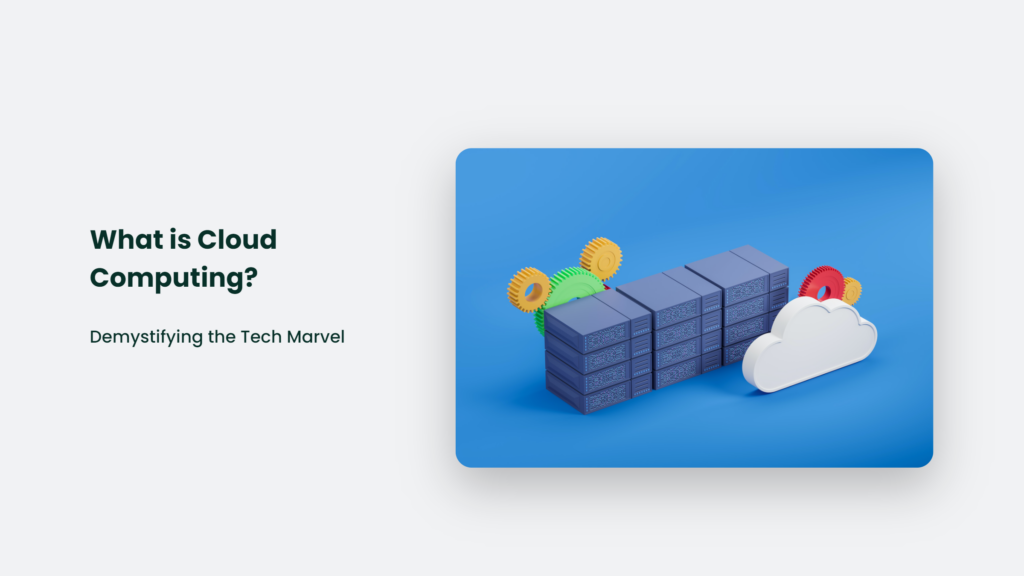

What is Cloud Computing? Demystifying the Tech Marvel

As Seen On
Are you ready to embark on a journey into cloud computing? Whether you’re a writer looking to break into this lucrative sector, a marketer aiming to deepen your understanding, or an IT professional seeking a broad overview, this guide is your one-stop resource for all things cloud computing.

What is Cloud Computing?
Let’s start from the beginning – what does “cloud computing” actually mean? It refers to storing data and running applications over the internet rather than on a local server or personal device. The “cloud” is a metaphor for the complex infrastructure enabling this concept.
To visualize cloud computing, imagine your documents, photos, emails, and other data stored far away in the atmosphere. You can access everything you need from any device with an internet connection. The cloud makes your data available everywhere at once – quite magical!
Of course, your information isn’t floating in the sky like a fluffy white cloud. It’s stored in massive data centres worldwide packed with powerful servers and hard drives. But an amorphous cloud captures how everything can be accessed instantly from anywhere. Nifty!
Why Use the Cloud?
So, what makes the cloud so special? For starters, it enables unprecedented flexibility and mobility. Have you ever tried lugging a server room around with you? I wouldn’t recommend it!
With the cloud, you can work seamlessly across all your devices – phone, tablet, laptop, desktop, fridge, toaster (?). Everything is connected and in sync. It’s productivity and convenience at its finest!
Plus, the cloud offloads the burden of hardware maintenance and upgrades. No more worrying about running out of storage or your computer crashing (phew!). The cloud provides almost unlimited capacity that can be scaled on demand.
Let me throw some stats at you:
- 82% of enterprise workloads will be in the cloud by 2020
- 90% of global companies will be using cloud technology by 2022
- Cloud computing is projected to be a $300 billion industry by 2023
As you can see, the cloud craze is real! Businesses especially are flocking to adopt cloud solutions for greater efficiency and agility. But even consumers rely heavily on the cloud for activities like storing photos online, streaming music, gaming, etc. Which leads nicely to…
Different Types of Cloud Services
The cloud landscape features 3 main models, each fulfilling distinct needs:
Infrastructure as a Service (IaaS)
It provides access to fundamental computing resources like servers, storage, and networking. It’s an outsourced data centre you can access on-demand. Examples include Amazon Web Services (AWS), Microsoft Azure, and Google Cloud Platform.IaaS offers high flexibility – quickly scale capacity up and down as needed without upfront investments. Major win!
Platform as a Service (PaaS)
Here, the cloud provider manages the underlying infrastructure while you build applications on top. So, with PaaS, you don’t have to configure servers or cluster databases. You develop, test, and deploy your software.
Salesforce’s Force.com and Heroku are big players for app development platforms. Reduced complexity for the win again!
Software as a Service (SaaS)
This model provides access to complete cloud-hosted apps you pay for on demand. Users log in and use the software via the internet. The classic example is email with providers like Gmail or Office 365.
But many modern apps live in the cloud, too – everything from accounting tools to graphic design to streaming services. There is so much functionality and so little effort on your end!
Cloudy With a Chance of…Hacker Attacks?
But is the cloud simply full of rainbows and unicorns? Well, no technology is 100% perfect or risk-free. Security remains a common concern surrounding cloud adoption.
After all, funnelling critical data and systems through the public internet raises some eyebrows. The cloud leaves that precious information outside the “four walls” of an on-premises system. One might suddenly imagine hackers parachuting in to cause mayhem!
However, cloud service providers invest tremendous resources into state-of-the-art security. Often far more than typical companies can manage alone! Encryption, access controls, advanced threat detection – they leverage it all.
And there are cloud-tailored security tools, too, like Cloud Access Security Brokers (CASBs). These enforce policies and monitor suspicious access. Some even detect compromised accounts by analyzing unusual user behaviour. How very Sherlock of them!
So, while caution is prudent, fears around cloud security are often exaggerated. Reputable providers offer robust protection you can trust.
Partly Cloudy to Overcast
Interestingly, many organizations use a blend of cloud and traditional local computing. This “hybrid cloud” approach provides the ideal balance and flexibility in some cases.
Keep core business systems and sensitive data on-premises while leveraging the cloud for less critical workloads. Or archive older data to the cloud while accessing current data locally. There are all sorts of permutations.
It gives organizations the reliability of a local system with the scalability and convenience of the cloud. Everyone’s happy!
Cloudy Forecast
Looking ahead, the future of cloud computing shines bright. As technology trends like smart devices, mobile connectivity, and big data analytics continue to grow, reliance on the cloud will strengthen. It’s sure to remain instrumental for business innovation, too.
And cloud providers rapidly advance capabilities around machine learning, blockchain, quantum computing, and more. Exciting developments ahead!
The impacts also extend beyond the technical landscape. Cloud computing enables modern collaboration methods that drive cultural shifts in the workforce. It spurs decentralized teams and remote work patterns. Even the dreaded middle managers can’t dampen the cloud’s potential to shake up old work paradigms!
Frequently Asked Questions:
What are the main benefits of cloud computing?
The cloud provides increased flexibility, scalability, collaboration capabilities, mobility, reduced hardware costs, almost unlimited capacity, and more. It allows organizations to innovate faster and pivot more easily.
Is the cloud secure?
Leading cloud providers offer extremely robust security tools and practices to protect data. However, users should still take measures like enabling multi-factor authentication when possible.
What are examples of cloud computing applications?
Cloud computing enables many popular apps like Gmail, Google Drive, Office 365, Adobe Creative Cloud, Salesforce, Dropbox, Slack, and more. Streaming media services are cloud-based as well.
Overcast Parting Thoughts
As we wrap up this guide, it’s clear that cloud computing marks a profound technological turning point. It introduces sweeping changes to leveraging IT resources while enabling incredible flexibility.
And despite a few wispy concerns around security or integration challenges, the cloud offers overwhelmingly positive potential. Minimal barriers and maximum outcomes – what’s not to love?
So next time you access your online documents or stream a show, take a moment to appreciate the marvel of cloud computing. We’ll leave you now to bask in the rays of this technological achievement!
Konger
Up until working with Casey, we had only had poor to mediocre experiences outsourcing work to agencies. Casey & the team at CJ&CO are the exception to the rule.
Communication was beyond great, his understanding of our vision was phenomenal, and instead of needing babysitting like the other agencies we worked with, he was not only completely dependable but also gave us sound suggestions on how to get better results, at the risk of us not needing him for the initial job we requested (absolute gem).
This has truly been the first time we worked with someone outside of our business that quickly grasped our vision, and that I could completely forget about and would still deliver above expectations.
I honestly can't wait to work in many more projects together!
Disclaimer
*The information this blog provides is for general informational purposes only and is not intended as financial or professional advice. The information may not reflect current developments and may be changed or updated without notice. Any opinions expressed on this blog are the author’s own and do not necessarily reflect the views of the author’s employer or any other organization. You should not act or rely on any information contained in this blog without first seeking the advice of a professional. No representation or warranty, express or implied, is made as to the accuracy or completeness of the information contained in this blog. The author and affiliated parties assume no liability for any errors or omissions.

